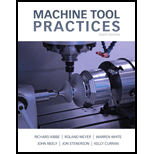
Machine Tool Practices (10th Edition)
10th Edition
ISBN: 9780132912655
Author: Richard R. Kibbe, Roland O. Meyer, Warren T. White, John E. Neely, Jon Stenerson, Kelly Curran
Publisher: PEARSON
expand_more
expand_more
format_list_bulleted
Concept explainers
Textbook Question
Chapter A.1, Problem 1ST
What is the primary piece of safety equipment in the machine shop?
Expert Solution & Answer
Want to see the full answer?
Check out a sample textbook solution
Students have asked these similar questions
PROBLEM 11:
Determine the force, P, that must be exerted on the handles of the bolt cutter.
(A) 7.5 N
(B) 30.0 N
(C) 52.5 N
(D) 300 N
(E) 325 N
.B
X
3 cm
E
40 cm
cm
F = 1000 N
10 cm
3 cm
bolt
Using the moment-area theorems, determine a) the rotation at A, b) the deflection at L/2, c) the deflection at L/4.
(Hint: Use symmetry for Part a (θA= - θB, or θC=0), Use the rotation at A for Parts b and c. Note that all deformations
in the scope of our topics are small deformation and for small θ, sinθ=θ).
Distilled water is being cooled by a 20% propylene glycol solution in a 1-1/U counter flow plate
and frame heat exchanger. The water enters the heat exchanger at 50°F at a flow rate of 86,000
lbm/h. For safety reasons, the water outlet temperature should never be colder than 35°F. The
propylene glycol solution enters the heat exchanger at 28°F with a flow rate of 73,000 lbm/h. The
port distances on the heat exchanger are Lv = 35 in and Lh = 18 in. The plate width is Lw = 21.5
2
in. The plate thickness is 0.04 in with a plate pitch of 0.12 in. The chevron angle is 30° and the
plate enlargement factor is 1.17. All ports have a 2 in diameter. The fouling factor of the propylene
glycol solution can be estimated as 2 ×10−5 h-ft2-°F/Btu.
a. Determine the maximum number of plates the heat exchanger can have while ensuring
that the water outlet temperature never drops below 35°F.
b. Determine the thermal and hydraulic performance of the heat exchanger with the specified
number of plates.…
Chapter A Solutions
Machine Tool Practices (10th Edition)
Ch. A.1 - What is the primary piece of safety equipment in...Ch. A.1 - Prob. 2STCh. A.1 - Prob. 3STCh. A.1 - Prob. 4STCh. A.1 - What hazards exist from coolants, oils, and...Ch. A.1 - Prob. 6STCh. A.1 - Prob. 7STCh. A.1 - Prob. 8STCh. A.1 - Prob. 9STCh. A.1 - Prob. 10ST
Ch. A.1 - Prob. 11STCh. A.2 - Define the term pitch diameter.Ch. A.2 - Name two ways to measure a thread.Ch. A.2 - What is the rule of thumb for the length of...Ch. A.2 - Describe when class two fits are used.Ch. A.2 - Describe UNC and UNF.Ch. A.2 - What is the formula for calculating the OD of a...Ch. A.2 - When are stud bolts used?Ch. A.2 - Prob. 9STCh. A.2 - Explain two reasons why flat washers are used.Ch. A.2 - What is the purpose of a helical spring lock...Ch. A.2 - When is an internal-external tooth lock washer...Ch. A.2 - When are dowel pins used?Ch. A.2 - When are taper pins used?Ch. A.2 - When are roll pins used?Ch. A.2 - What are retaining lings?Ch. A.2 - Prob. 17STCh. A.2 - Prob. 18STCh. A.2 - Prob. 19STCh. A.3 - Prob. 1STCh. A.3 - Prob. 2STCh. A.3 - Prob. 3STCh. A.3 - Prob. 4STCh. A.3 - Prob. 5STCh. A.3 - Prob. 6STCh. A.3 - Prob. 7STCh. A.3 - Prob. 8STCh. A.3 - Prob. 9STCh. A.3 - Prob. 10STCh. A - Companies are looking for people with good...Ch. A - Prob. 4STCh. A - Prob. 5STCh. A - Prob. 6STCh. A - What is the basis of the five S tool?Ch. A - Prob. 8STCh. A - Prob. 9STCh. A - What is poka-Yoke?
Knowledge Booster
Learn more about
Need a deep-dive on the concept behind this application? Look no further. Learn more about this topic, mechanical-engineering and related others by exploring similar questions and additional content below.Similar questions
- Liquid pentane is flowing in the shell of a shell and tube heat exchanger at a rate of 350,000lbm/hr and an average temperature of 20°F. The shell has a diameter of 27 in and a length of 16ft. The tubes in the heat exchanger are ¾-in 15 BWG tubes on a 1-in triangular pitch. The purposeof this problem is to investigate how the number of baffles impacts the heat transfer and thepressure drop on the shell side of the heat exchanger. Calculate the shell-side convective heattransfer coefficient and pressure drop for the case where the heat exchanger has 10 baffles. Repeatthe calculation for 20 baffles. Then determine thea. Ratio of the shell-side convective heat transfer coefficient for the 20-baffle heat exchangerto the 10-baffle heat exchangerb. Ratio of the shell-side pressure drop for the 20-baffle heat exchanger to the 10-baffle heatexchangerc. If the optimum baffle spacing is somewhere between 0.4Ds and 0.6Ds, how many baffleswould you recommend for this heat exchanger? What are the…arrow_forwardThe evaporator of a vapor compression refrigeration cycle utilizing R-123 as the refrigerant isbeing used to chill water. The evaporator is a shell and tube heat exchanger with the water flowingthrough the tubes. The water enters the heat exchanger at a temperature of 54°F. The approachtemperature difference of the evaporator is 3°R. The evaporating pressure of the refrigeration cycleis 4.8 psia and the condensing pressure is 75 psia. The refrigerant is flowing through the cycle witha flow rate of 18,000 lbm/hr. The R-123 leaves the evaporator as a saturated vapor and leaves thecondenser as a saturated liquid. Determine the following:a. The outlet temperature of the chilled waterb. The volumetric flow rate of the chilled water (gpm)c. The UA product of the evaporator (Btu/h-°F)d. The heat transfer rate between the refrigerant and the water (tons)arrow_forwardThe blade support of a hacksaw is subject to compression when a blade is installed and tightened. What is the state of stress (total combined stress) at A in MPa if the compression in the support is 1,524 N. Note: pay close attention to what is compression and what is tension and use a negative sign for the former. 100 mm 8 mm 3 mm 75 mm A 8 mm 3 mm B 50 mmarrow_forward
- An open channel of square cross section had a flowrate of 17.2 ft³/s when first used. After extended use, the channel became 0.6-filled with silt. Determine the flowrate for this silted condition. Assume the Manning coefficient is the same for all the surfaces. Qs= ! ft³/sarrow_forward(Manning equation) The triangular flume shown in the figure below is built to carry its design flowrate, Qo, at a depth of 0.991 m as is indicated. If the flume is to be able to carry up to twice its design flowrate, Q = 2Qo, determine the freeboard, I, needed. ✓ -90°- 0.991 m i marrow_forwardWater flows in a 2-ft-wide rectangular channel at a rate of 10 ft³/s. If the water depth downstream of a hydraulic jump is 2.5 ft, determine (a) the water depth upstream of the jump, (b) the upstream and (c) downstream Froude numbers, and (d) the head loss across the jump. (a) y₁ = i (b) Fr₁ = i (c) Fr₂ = i (d) h₁ = ft ftarrow_forward
- A hydraulic jump at the base of a spillway of a dam is such that the depths upstream and downstream of the jump are 0.8 and 3.2 m, respectively (see the Video). If the spillway is 12 m wide, what is the flowrate over the spillway? Q= i m³/sarrow_forward(Manning equation) Water flows in a rectangular channel of width b at a depth of b/2. Determine the diameter of a circular channel (in terms of b) that carries the same flowrate when it is half-full. Both channels have the same Manning coefficient, n, and slope. barrow_forward(Manning equation) A weedy irrigation canal of trapezoidal cross section is to carry 20 m³/s when built on a slope of 0.60 m/km. If the sides are at a 45° angle and the bottom is 8 m wide, determine the width of the waterline at the free surface. i marrow_forward
arrow_back_ios
SEE MORE QUESTIONS
arrow_forward_ios
Recommended textbooks for you
 Precision Machining Technology (MindTap Course Li...Mechanical EngineeringISBN:9781285444543Author:Peter J. Hoffman, Eric S. Hopewell, Brian JanesPublisher:Cengage Learning
Precision Machining Technology (MindTap Course Li...Mechanical EngineeringISBN:9781285444543Author:Peter J. Hoffman, Eric S. Hopewell, Brian JanesPublisher:Cengage Learning Welding: Principles and Applications (MindTap Cou...Mechanical EngineeringISBN:9781305494695Author:Larry JeffusPublisher:Cengage Learning
Welding: Principles and Applications (MindTap Cou...Mechanical EngineeringISBN:9781305494695Author:Larry JeffusPublisher:Cengage Learning Automotive Technology: A Systems Approach (MindTa...Mechanical EngineeringISBN:9781133612315Author:Jack Erjavec, Rob ThompsonPublisher:Cengage Learning
Automotive Technology: A Systems Approach (MindTa...Mechanical EngineeringISBN:9781133612315Author:Jack Erjavec, Rob ThompsonPublisher:Cengage Learning Automotive TechnologyMechanical EngineeringISBN:9781337794213Author:ERJAVEC, Jack.Publisher:Cengage,
Automotive TechnologyMechanical EngineeringISBN:9781337794213Author:ERJAVEC, Jack.Publisher:Cengage,

Precision Machining Technology (MindTap Course Li...
Mechanical Engineering
ISBN:9781285444543
Author:Peter J. Hoffman, Eric S. Hopewell, Brian Janes
Publisher:Cengage Learning

Welding: Principles and Applications (MindTap Cou...
Mechanical Engineering
ISBN:9781305494695
Author:Larry Jeffus
Publisher:Cengage Learning

Automotive Technology: A Systems Approach (MindTa...
Mechanical Engineering
ISBN:9781133612315
Author:Jack Erjavec, Rob Thompson
Publisher:Cengage Learning

Automotive Technology
Mechanical Engineering
ISBN:9781337794213
Author:ERJAVEC, Jack.
Publisher:Cengage,
General Industrial Safety; Author: Jim Pytel;https://www.youtube.com/watch?v=RXtF_vQRebM;License: Standard youtube license